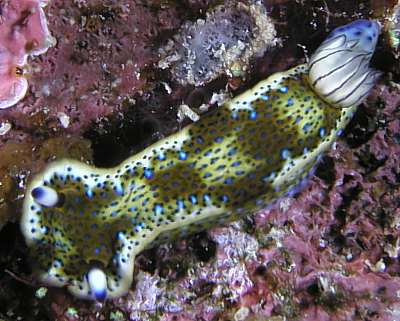
Hypselodoris olgae
Ortea & Bacallado, 2007
Order: NUDIBRANCHIA
Suborder: DORIDINA
Superfamily: EUDORIDOIDEA
Family: Chromodorididae
DISTRIBUTION
Caribbean
PHOTO
Little Cayman, Cayman Ids, Caribbean. [on a vertical section of Bloody Bay Wall, at 16m]. Jan 19, 2002. Photo: Rod Dickson.
This species has previously been called Hypselodoris sp. 5 on the Forum.
Apart from the general colour pattern, distinctive features of the colour pattern include the white rhinophore clubs with dark blue tips and dark blue stalks, the simple white gills edged in blue, and the regular pattern of dark patches down the mantle, including the pair midway down the mantle which form a break in the white band around the mantle edge. The authors report specimens from the sponge Dysidea etheria and note that the eggs are relativley large, suggesting that it is possibly a direct developer.
This animal is almost certainly the same as the one in Humann's book [Hypselodoris sp. p235]. It is also identical to the animal Thompson, (1980) identified from Jamaica as Hypselodoris bayeri but as Thompson notes, his animal had considerable colour differences from H. bayeri as originally described by Marcus & Marcus 1967 from Florida. True H. bayeri has deep blue rhinophores and a series of yellow longitudinal lines down the back. It also lacks the break in the mantle border halfway down each side. Thompson reports numerous live specimens creeping over coral sand near Discovery Bay and Port Royal (16-30 mm long). He twice found them feeding on a dark brown encrusting sponge.
This is one of a group of similarly coloured species from the Caribbean and west Atlantic which are still not satisfactorily resolved. For example this species was misidentified as H. marci in the latest revision on this colour group (Ortea, Valdes & Garcia-Gomez, 1997).
-
Ortea, J. & Bacallado, J. J. (2007) Descripción de una nueva especie de Hypselodoris Stimpson, 1855 (Mollusca: Nudibranchia: Chromodorididae) nombrada en homenaje a Olga Ucelay Sabina. Revista Academia Canaria de las Ciencias, 18, 53-60.
-
Ortea, J., Valdés, A. & García-Gómez, J. C. (1996) Review of the atlantic species of the Family Chromodorididae (Mollusca: Nudibranchia) of the blue chromatic group. Avicennia, Supplement 1: 1-160.
-
Thompson, T.E. (1980) Jamaican opisthobranch molluscs: II. Journal of Molluscan Studies, 46(1): 74-99.
Rudman, W.B., 2009 (March 25) Hypselodoris olgae Ortea & Bacallado, 2007. [In] Sea Slug Forum. Australian Museum, Sydney. Available from http://www.seaslugforum.net/find/hypsolga
Related messages
Hypselodoris olgae feeding record from Florida
May 20, 2009
From: Linda Ianniello
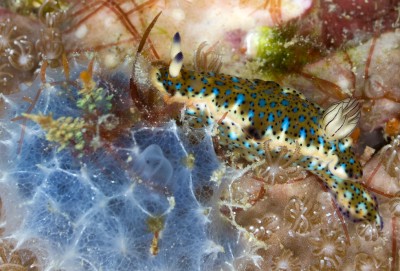
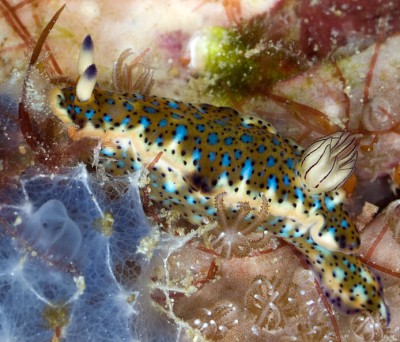
Concerning message #8104:
Hi, Dr. Bill. Here is an image of Hypselodoris olgae feeding on a sponge, for your collection of "food sponges". I hope it is of interest.
Locality: Delray Ledges, 50 feet, Florida, USA, Atlantic, 5 March 2006, Coral reef. Length: 1.5 inches. Photographer: Linda Ianniello.
Regards,
Linda I.
lindai1@bellsouth.net
Ianniello, L.M., 2009 (May 20) Hypselodoris olgae feeding record from Florida. [Message in] Sea Slug Forum. Australian Museum, Sydney. Available from http://www.seaslugforum.net/find/22486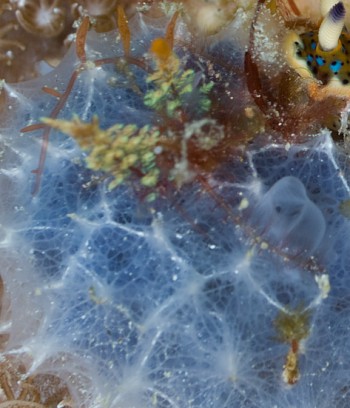
Thanks Linda,
It is definitely of interest as is the first information we have on the food preference of H. olgae. The sponge, Dysidea etheria, is the species which you recently found H. ruthae feeding on [message #22485]. It is a valuable addition to our knowledge.
Best wishes,
Bill Rudman
Re: Hypselodoris sp. 5 from Key Largo, Florida
March 25, 2009
From: Vinicius Padula
Concerning message #22345:
Dear Bill and Katrina,
This morphotype was described as a new species Hypselodoris olgae by Ortea & Bacallado (2007) based on specimens collected at Mexico and Cuba.
It was previously misidentified with Hypselodoris marci at Ortea et al.(1996) paper.
I believe that all the animals you have called Hypselodoris sp. 5 on the Forum are H. olgae except for the specimen from Brian Mayes [message #9824] which probably belongs to another species. What species? I don´t know. It is only one of the many morphotypes that occur at the Caribbean Sea which need more investigation.
-
Ortea, J. & Bacallado, J.J. (2007 for 2006) Descripción de una nueva especie de Hypselodoris Stimpson, 1855 (Mollusca: Nudibranchia: Chromodorididae) nombrada en homenaje a Olga Ucelay Sabina. Revista de la Academia Canaria de Ciencias, 18(4): 53-60.
Best Regards,
Vinicius
viniciuspadula@yahoo.com
Padula, V., 2009 (Mar 25) Re: Hypselodoris sp. 5 from Key Largo, Florida. [Message in] Sea Slug Forum. Australian Museum, Sydney. Available from http://www.seaslugforum.net/find/22347Dear Vinicius,
Thanks for letting me know about H. olgae and for sending me a copy of Ortea & Bacallado's paper which I had not as yet seen. Certainly there is more work needed on these Caribbean - West Atlantic species. I see the authors suspect this species is a direct developer from the size of the eggs. Direct development can lead to speciation or 'subspeciation' through genetic isolation but there are also many examples of direct developing species with wide geographic distributions. If there are a group of similarly coloured species, then Brian Mayes animal [#9824] could well be different as it lacks a dark blue rhinophore tip. In many ways it looks like the animal I have identified as H. marci [see #13280]. Apart from solving the biological puzzle of just how many species there are in this group, we also have the unfortunate nomenclatural puzzle of interpreting the original description of H. marci.
Best wishes,
Bill Rudman
Hypselodoris sp. 5 from Key Largo, Florida
March 18, 2009
From: M Katrina Smith
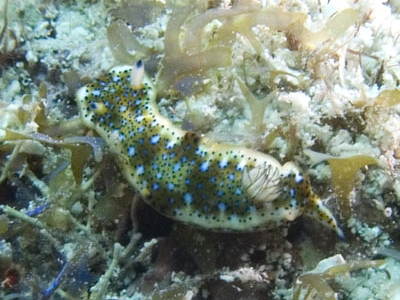
Note added 25 March 2008: This species, which has been called Hypselodoris sp. 5 on the Forum, has now been named Hypselodoris olgae - see message #22347.
Concerning message #6082:
I posted this photo on the ScubaBoard to verify the ID. One of my replies suggested that I post the photo and information here as well. According to the Humann & Deloach book, this has not previously been known in Florida. I photographed it at Snapper's ledge off Key Largo, Florida. My depth was about 20-25 feet. I have other photos and larger file sizes if you would like additional information.
Locality: Key Largo, 20 to 25 feet, Florida, USA, Atlantic Ocean, 16 March 2009, reef. Length: 1 to 1.5 inches. Photographer: M. Katrina Smith.
M. Katrina Smith
mksmith11@windstream.net
Smith, M. K., 2009 (Mar 18) Hypselodoris sp. 5 from Key Largo, Florida. [Message in] Sea Slug Forum. Australian Museum, Sydney. Available from http://www.seaslugforum.net/find/22345Dear Katrina,
Thanks for the record. As you will see from the other messages attached to the species Fact Sheet, we have a number of records of this species from Florida. Its identification is still a bit of a problem as we still have insufficient information to know whether several similar looking 'species' are actually true species or just variations of one species.
I was interested in your mention of other photos as we still have much to learn about the basic biology of most of these species. They are sponge feeders but each species only feeds on one or a very few species of sponge, and as yet we don't have good information on what most species eat. I can't see any sign of a sponge in the present photo but perhaps amongst your other photos there will be one with a sponge?
Best wishes,
Bill Rudman
Hypselodoris sp. 5 from the West Indies
June 25, 2007
From: Jim Chambers
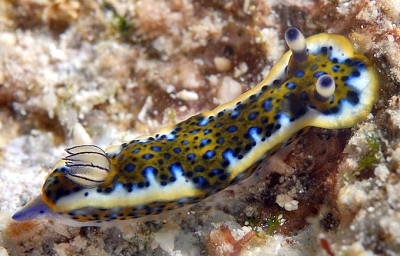
Note added 25 March 2008: This species, which has been called Hypselodoris sp. 5 on the Forum, has now been named Hypselodoris olgae - see message #22347.
G'Day, Bill.
While diving on Little Cayman, BWI (Caribbean Sea) on May 27, 2006, I saw a little nudibranch that I think is a Purple-Spotted Sea Goddess (Hypselodoris marci) although it also resembles Hypselodoris cf. acriba, on hardpan at a depth of about 10 meters. It was about 15 mm in size. Since I don't see this species reported in Little Cayman, I thought I would submit it to you and also to try to get a positive ID.
Cheers,
Jim Chambers
Georgia USA
jimbo1946@mindspring.com
Chambers, J., 2007 (Jun 25) Hypselodoris sp. 5 from the West Indies. [Message in] Sea Slug Forum. Australian Museum, Sydney. Available from http://www.seaslugforum.net/find/20038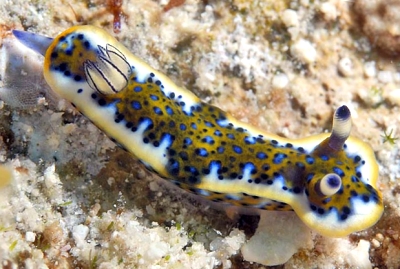
Dear Jim,
This is what I am calling on the Forum Hypselodoris sp. 5 because I am pretty sure it is an unnamed species. As I discuss on the Fact Sheet and in an earlier message [#7803] it has been identified - I think incorrectly - as H. marci and H. bayeri, but part of the problem is the poor original descriptions of many Caribbean species. I see in Caribbean Sea Slugs that the authors agree that this is probably an unnamed species. I am not sure what you mean by 'Hypselodoris cf. acriba'. There is one labelled that in Caribbean Sea Slugs which is the same as one on the Forum [message #9824] as possibly Hypselodoris sp. 5, but we have much to learn about these animals and it could be another unnamed species. Understanding and comparing their anatomy is going to be vital, but it will be meaningless if we don't have an equally good understanding of their external shape, colour and variability. Which is why your photos are so welcome
Best wishes,
Bill Rudman
Hypselodoris sp. 5 - Key Largo, Florida
February 17, 2004
From: Paul Osmond
Note added 25 March 2008: This species, which has been called Hypselodoris sp. 5 on the Forum, has now been named Hypselodoris olgae - see message #22347.
We found a specimen of Hypselodoris marci in Key Largo, Florida this weekend (Feb 14 2004), or at least the nudibranch that matches that name as shown in Humann's Reef Creatures.
Some things to note - it is a very different looking species than Hypselodoris acriba. It lacks H. acriba's ruffles - the edge is very smooth and is broken at the midsection with an extention of the back color. The anal gills were white, the rhinopores were half purple, half white. Coloration was almost exactly as shown in Humann's. Underneath the speciman was purple - sides were similarly colored as the back with spots extending the length of the body including the 'tail'
Unfortunately I had a wide angle lens on and the speciman was less than an inch long, so no images. That is too often the case.
Thanks,
Paul
marriard@deepseaimages.com
Osmond, P., 2004 (Feb 17) Hypselodoris sp. 5 - Key Largo, Florida. [Message in] Sea Slug Forum. Australian Museum, Sydney. Available from http://www.seaslugforum.net/find/12224Thanks Paul,
This is the species I am calling Hypselodoris sp. 5 on the Forum. I have discuss in another message [#7803] why I think Hypselodoris marci is something else, perhaps even a form of H. acriba. Unfortunately the original description is rather confusing.
Your message also gives me a chance to mention Paul Humann & Ned DeLoach's excellent 2nd Edition to their Reef Creature Guide book. Naturalists in the Caribbean are lucky to have such a comprehensive publication.
Best wishes
Bill Rudman
Re: Hypselodoris from Bonaire
May 28, 2003
From: Brian Mayes
Note added 25 March 2008: This species, which has been called Hypselodoris sp. 5 on the Forum, has now been named Hypselodoris olgae - see message #22347.
Dear Bill,
With reference to your reply your reply to Ron Velarde dated 27th May 2003 on the Forum. I think you have your comments round the wrong way. Mine is the one with the light purple rhinophores and dark purple tip.
With regard to Ron's comments on the colour variations being related to size. The one in my photo is about 0.75 inch or 19mm long. The photo by Craig Lavin shows the size to be less than the width of a finger. The photo by Linda Ianniello from Anne Dupont states it to be about 1 inch. Both these have white rhinophores with dark tips. Mine is in the middle of this size range but has purple/blue rhinopores with tiny darker tips.
Colour comparions are difficult because of the different cameras, depths and lighting used by the photographers. For future reference my photo was taken using a digital camera (Nikon Coolpix 990) and video light (Pro Video-Lite). I assume that your earliest photos were taken with conventional cameras and strobes.
Kind Regards
Brian Mayes
brian@mayescai.freeserve.co.uk
Mayes, B., 2003 (May 28) Re: Hypselodoris from Bonaire. [Message in] Sea Slug Forum. Australian Museum, Sydney. Available from http://www.seaslugforum.net/find/10068Dear Brian,
Concerning the rhinophore colour of your animal. Just a slight brainstorm on my part. I have altered my comment. I don't usually change already posted messages but it will only cause unnecessary confusion to leave it as is.
Thanks also for the length information. Concerning colour comparisons. Certainly there can be differences between cameras - even digital cameras can give rather different results just as different film types do. My feeling is that trying to define an exact colour [by wavelength etc] is not of much value because in nature colours vary between individuals. Obviously we need to know the general colours - such as red spots or orange-yellow border - but what is vitally important is the 'pattern'. Whether the red spots on the mantle always occur with a yellow border and with blue spots on the rhinophores etc. This information can only be gathered by studying many specimens so we get to know what variations can occur in the actual colours and what variations can occur in the pattern. For example can yellow spots sometimes be orange and can a line of red spots sometimes be a red line etc? And as Ron suggested do juveniles and adult colours differ?
These aren't things immediately obvious from a single specimen, so the more records and photos we can accumulate the easier it will be to work out what is going on.
Best wishes,
Bill Rudman
Hypselodoris from Bonaire (Caribbean)
May 20, 2003
From: Brian Mayes
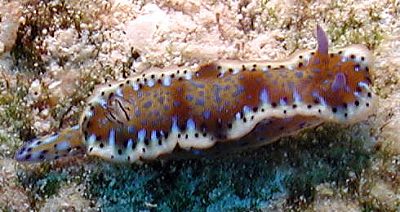
Note added 25 March 2008: The species, which has been called Hypselodoris sp. 5 on the Forum, has now been named Hypselodoris olgae. The animal in this message may or may not be Hypselodoris olgae but I will leave it here at present- see message #22347.
On 24th April 2003,I found a small Nudibranch while diving off the Carribean Island of Bonaire.
It was at a depth of 8 metres and was in a area of coral rubble and sand on "Reef Scientifico" opposite Captain Don's Habitat.
Using Humann's Reef Creature Book, I identified it as a Purple-spotted Sea Goddess, Hypselodoris species, not found in that area. I consulted local Marine Biologist Dee Scarr, and she stated that the latest edition of the book showed it to be "Uncommon, Northwest Caribbean, Venezuela, also south to Brazil.". She also stated "On the other hand, note that the critter in the Humann books (same photo both editions) shows dark purple tips on white rhinophores (feeler-thingies in the front), while yours has purple rhinophores with tiny very dark tips. Can you help with Identification and say if this is has been found before in Bonaire
Brian Mayes
brian@mayescai.freeserve.co.uk
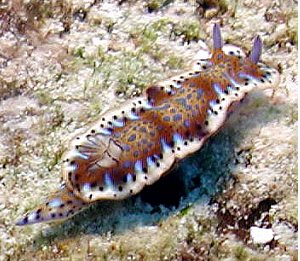
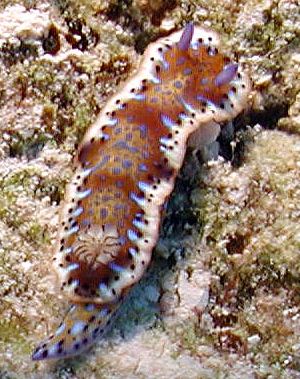
Dear Brian,
I am afraid that some of the chromodorids in the Caribbean are still in a bit of confusion. Publishing photos of them like this so we get a better idea of their variability will help give us a better idea of how many species there are.
This is what I am calling on the Forum Hypselodoris sp. 5. If you look on that page you will see some of the discussion about its identity. It looks quite like the photo of H. bayeri in Marcus & Marcus (1967) - if we ignore lack of lines. Unfortunately until we get a better idea on just what is a species, its a little difficult to know whether it has been recorded from Bonaire before. I may be wrong but I suspect the chance of Bonaire having a unique endemic marine fauna is fairly slight. It more probable that the marine fauna of Bonaire is very similar, if not identical to that of similar habitats eleswhere in the Caribbean.
Rudman, W.B., 2003 (May 20). Comment on Hypselodoris from Bonaire (Caribbean) by Brian Mayes. [Message in] Sea Slug Forum. Australian Museum, Sydney. Available from http://www.seaslugforum.net/find/9824Hypselodoris sp. 5. from Florida
October 8, 2002
From: Anne DuPont
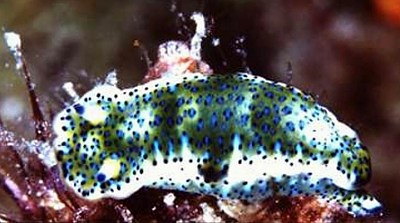
Note added 25 March 2008: This species, which has been called Hypselodoris sp. 5 on the Forum, has now been named Hypselodoris olgae - see message #22347.
Dear Bill,
I saw your post to Craig Lavin regarding his Hypselodoris species photograph taken in the Florida Keys. In July, 2001, Linda Ianniello (lindai@us.ibm.com) found this Hypselodoris sp. on a reef off Boca Raton, Florida. I am sending you Linda's photograph [upper right] and two photographs of mine.
Is this your Hypselodoris sp 5? The size was about 1 inch long and there were 2 of them in the algae on top of a 60 foot reef on the edge of the drop-off. The photographs were taken July, 2001.
Thank you for all your help and the wonderful forum.
Cordially,
Anne DuPont
Delray Beach,
Florida USA
akdupont@bellsouth.net
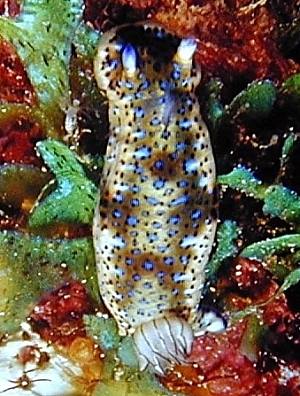
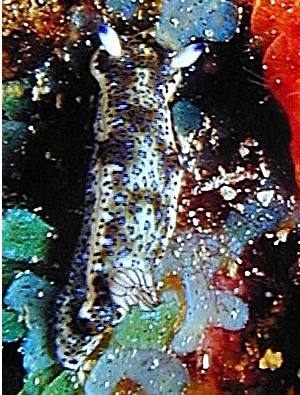
Thanks Anne,
Yes this is Hypselodoris sp. 5.
Best wishes,
Bill Rudman
Hypselodoris marci? from Florida
September 17, 2002
From: Craig Lavin
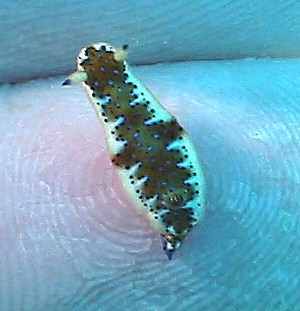
Note added 25 March 2008: This species, which has been called Hypselodoris sp. 5 on the Forum, has now been named Hypselodoris olgae - see message #22347.
You have a great forum! This Nudibranch was photographed in Key largo- It has the white edging break as H. marci does, however there is considerable variaion in the amount of brown/blue dots. I found it under a rock in about 25' depth, searching for nudibranchs...
The reef type was small spurs, with rubble between. Humann's book has the range listed as Uncommon, Northwest Caribbean, Venezuala, also south to Brazil. If so is this the first reporting from Florida for this species?
Please let me know, as I am a high school marine biology teacher, and this would make my class very excited!
Craig Lavin
clavin@attbi.com
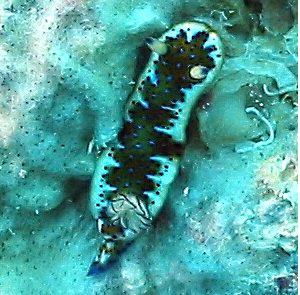
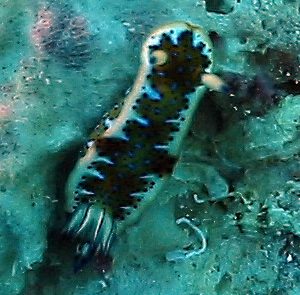
Dear Craig,
I think your animal is one I already have on the Forum as Hypselodoris sp. 5. My edition of Humann [1992 edition, 5th printing 1999] doesn't have a species identified as H. marci but there is an unnamed one at the bottom of page 234-5, which looks quite similar. Your animal is identical to one identified as H. marci by Ortea, et. al (1996). However the big problem is Marcus' original description of H. marci. Her description is based on 2 preserved animals and a colour slide of what I presume is an animal from Brazil. She describes a red line along the mantle edge and describes the gills as red with a blue rachis. There are large blue spots forming a submarginal band along the mantle edge with a white background. She describes a black blotch about midway down each side, and describes the midregion of the mantle as white with 'small areas free around the blue notal glands. These stipples are often eye spots with a light blue center'. The rhinophores are blue-tipped.
I have great difficulty in understanding her description and her black & white drawing of th preserved animal suggest that the mid region of the mantle is light coloured with dark stippling, not a dark colour with some lighter spots as in your animal. In her discussion she suggests it is quite close to Hypselodoris acriba and I wouldn't be surprised if it turns out to be that species.
Tom Thompson (1980) reports an identical animal to yours from Jamaica but misidentifies it as Hypselodoris bayeri. So basically I think your animal is an unnamed species. However we cannot be sure of this until someone is able to sort out just what Hypselodoris marci is. Another good reason not to name new species from one or two preserved specimens. I wish the International Code was as strict in including essential characters in species descriptions as it was in getting the Latin correct.
What should you tell your class? One of the important lessons to get across is how little we know about our environment. Here is a perfect example. In waters lapping the coast of the most technologically advanced country in the world are animals we know nothing about and our funding agencies seem unwilling to fund the research needed to investigate them. The saddest thing is that technological advancement comes at an enormous cost in environmental degradation and these unknown organisms, in your own front yard, may be extinct before we even know of their existence.
References:
• Ortea, J., Valdés, A. & and García-Gómez, J.C. (1996) Revisión de las especies atlánticas de la familia Chromodorididae (Mollusca: Nudibranchia) de grupo cromático azul. [Review of the Atlantic species of the family Chromodorididae (Mollusca: Nudibranchia) of the blue chromatic group.] Avicennia, 1996, Suppl. 1: 1-165.
• Thompson, T.E. (1980) Jamaican opisthobranch molluscs: II. Journal of Molluscan Studies, 46(1): 74-99.
Best wishes,
Bill Rudman.
'Sea goddess' from Cayman Ids
January 27, 2002
From: Rod Dickson
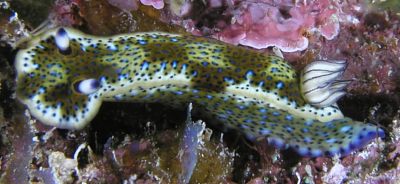
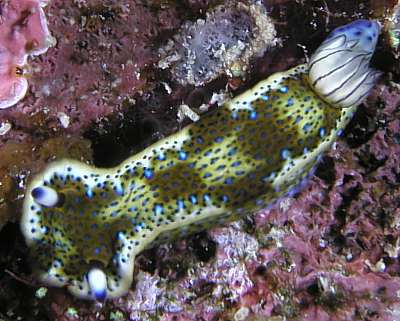
Note added 25 March 2008: This species, which has been called Hypselodoris sp. 5 on the Forum, has now been named Hypselodoris olgae - see message #22347.
Hi Bill,
Can you please help me identify this sea goddess?
I found it on Jan 19, 2002, at a depth of 16m on a vertical section of Bloody Bay Wall, Little Cayman, [Cayman Ids, Caribbean]where I work as a dive instructor.
I checked your Hypselodoris sp photos out and can't find a match. It appears similar to the Hypselodoris sp. in Humann's book, which he calls the 'purple-spotted sea goddess'. Mine has bright blue spots, rather than purple, and a clear checkerboard pattern on its back.
Sincerely,
Rod Dickson
PADI OWSI
Little Cayman Island
chillin@candw.ky
Dickson, R., 2002 (Jan 27) 'Sea goddess' from Cayman Ids. [Message in] Sea Slug Forum. Australian Museum, Sydney. Available from http://www.seaslugforum.net/find/6082Dear Rod,
Your animal is almost certainly the same as the one in Humann's book [Hypselodoris sp. p235]. It is also identical to the animal Thompson, (1980) identified from Jamaica as Hypselodoris bayeri but as Thompson notes, his animal had considerable colour differences from H. bayeri as originally described by Marcus & Marcus 1967 from Florida. True H. bayeri has deep blue rhinophores and a series of yellow lonmgitudinal lines down the back. It also lacks the break in the mantle border halfway down each side. Thompson reports numerous live specimens creeping over coral sand near Discovery Bay and Port Royal (16-30mm long). He twice found them feeding on a dark brown encrusting sponge.
I agree with Humann that this is probably an undescribed species. Apart from the general colour pattern, distinctive features of the colour pattern include the white rhinophore clubs with blue tips, the simple white gills edged in blue, and the regular pattern of dark patches down the mantle, including the pair midway down the mantle which form a break in the white band around the mantle edge.
If you have other photos of slugs from the Caribbean, even those you have identified, they would be of great interest to Forum visitors. As you will have noticed out knowledge of the Caribbean fauna is not that great, and will only improve as we learn more about colour variation and geographic distribution of the species found there.
• Thompson, T.E. (1980) Jamaican opisthobranch molluscs: II. Journal of Molluscan Studies, 46(1): 74-99.
Best wishes,
Bill Rudman
